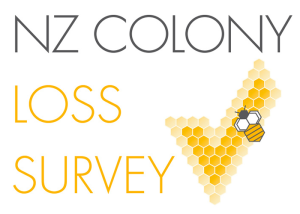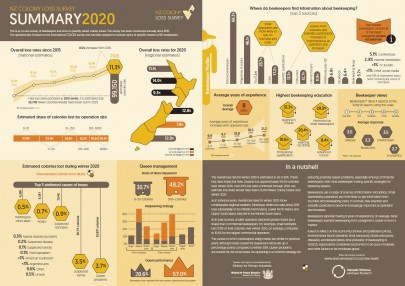2020 Colony Loss Survey
In this section
 Survey topics include the number and nature of over-winter colony losses, queen health and performance, indicators of diseases and parasites, treatment of Varroa, supplemental feeding, and colony management. Because the challenges facing New Zealand beekeepers differ from those facing beekeepers in the northern hemisphere, the survey also includes questions that are specific to to the New Zealand context, e.g. apiary crowding, predation by wasps, and nectar flow from native trees.
Survey topics include the number and nature of over-winter colony losses, queen health and performance, indicators of diseases and parasites, treatment of Varroa, supplemental feeding, and colony management. Because the challenges facing New Zealand beekeepers differ from those facing beekeepers in the northern hemisphere, the survey also includes questions that are specific to to the New Zealand context, e.g. apiary crowding, predation by wasps, and nectar flow from native trees.
For the purpose of completing the survey, winter is defined as the period between 1 June and the time the beekeepers open their hives for the first spring round.
In a nutshell
The overall loss rate for winter 2020 is estimated to be 11.30%. These loss rates imply that New Zealand lost approximately 99,150 colonies over winter 2020. Had 2015 loss rates continued through 2020, we estimate that there would have been 25,700 fewer colony losses over winter 2020.
As in previous years, overall loss rates for winter 2020 show considerable regional variation. Moreover, while loss rates since 2019 rose substantially in the Middle North Island, Lower North Island, and Upper South Island, they fell in the Middle South Island.
As in past surveys, smaller operators reported greater losses (as a share) than commercial beekeepers. For example, small hobbyists lost 27.9% of their colonies over winter 2020, on average, compared to 10.4% for the largest commercial operators.
The causes to which beekeepers assign losses are similar to previous years, although losses caused by suspected varroa are up 3 percentage points compared to winter 2019. Queen problems accounted for the most losses. Re-queening is a common strategy for reducing potential queen problems, especially among commercial beekeepers, with most beekeepers having specific strategies for replacing queens.
Beekeepers use a range of sources of information and advice. Small beekeeping operations are more likely to get information from YouTube and beekeeping clubs. In contrast, bee scientists and scientific publications become increasingly important as operation size increases.
Beekeepers reported having 8 years of experience, on average. Most beekeepers learned beekeeping from a beginner’s course or from a mentor.
Asked to reflect on the economics (honey and pollination prices), environmental factors (weather, floral resources), biosecurity (pests, diseases), and lifestyle (stress, time pressure) of beekeeping in 2019/20, respondents considered economics to be poor-moderate and other factors to be moderate-good.
2020 winter losses












2019/20 season














































